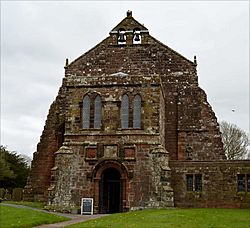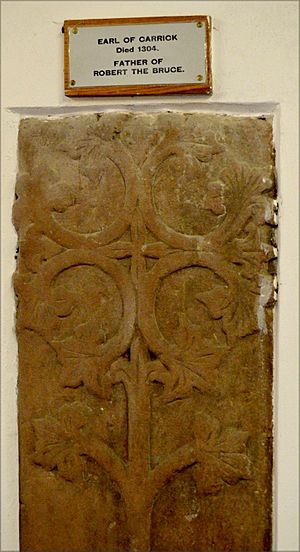Holmcultram Abbey facts for kids

Holmcultram Abbey 2017
|
|
| Monastery information | |
|---|---|
| Full name | Holmcultram Abbey |
| Order | Cistercian |
| Established | 1150 |
| Disestablished | 1538 |
| Diocese | Carlisle |
| Site | |
| Location | Abbeytown, Cumbria |
| Visible remains | Nave; now a parish church |
| Public access | Yes |
Holmcultram Abbey is an old Cistercian monastery in Abbeytown, Cumbria, United Kingdom. It was started in 1150. In 1538, it was closed during a time called the Dissolution of the Monasteries. Today, the old church part of the abbey is still used as a parish church for people to worship.
Contents
Holmcultram Abbey: A Historic Place
Holmcultram Abbey is a very old place. It was once a home for Cistercian monks. These monks were part of a special religious group. The abbey is located in a village now called Abbeytown. This village is in Cumbria, which is in the United Kingdom.
How the Abbey Started
The abbey began in 1150. Cistercian monks from Melrose Abbey came to start it. They built it on land given by Alan of Allerdale. This land was once part of Scotland.
Prince Henry gave the land for the abbey. The stone used to build it came from north of the Solway Firth. Later, Henry II of England took back the area. He confirmed the land gift in 1157.
The abbey also rented land in Galloway, Scotland. They kept this land for 200 years. But they sold it when Englishmen could no longer own land in Scotland.
Life at the Abbey
Holmcultram Abbey became very successful. The monks gained more land in north Cumberland. They also worked to reclaim land along the Solway coast. In 1301, they were allowed to hold a market in Skinburness. They also got permission to build a church there.
However, strong storms damaged Skinburness. So, the market and church permissions moved to Newton Arlosh. The abbey built a strong, fortified church there. This church was called a chapel of ease.
The abbey faced many attacks from Scottish raiders. This happened even though the abbey had Scottish beginnings. Attacks started in 1216 and continued. A very bad attack happened in 1319. This was led by Robert the Bruce. This happened even though his own father was buried at the abbey.
In 1193, the community started another abbey. This new abbey was called Grey Abbey. It was built in County Down, which is in Northern Ireland.
The Abbey's End
The abbey was closed down in 1538. This was part of the Dissolution of the Monasteries. During this time, many monasteries in England were closed. The local people asked to use the church part of the abbey. Their wish was granted. The abbot, who was the head monk, became the first rector of the new parish church.
What the Abbey Looked Like
The abbey buildings were made from red sandstone. This stone came from across the Solway. Digs since 2006 show how the buildings were laid out. They followed the usual plan for Cistercian monasteries.
The church was on the north side of a central courtyard, called a cloister. Other buildings were on the other three sides. The dining hall, or refectory, was opposite the church. The chapter house was to the west.
Over time, the church changed a lot. Parts of it collapsed, like the tower in 1600. It also had many changes made to it. The church became smaller, only using the first six sections of the nave. The roof was also lowered. The church was repaired twice, in 1883 and 1913. Even with all these changes, it is still a large building. It continues to serve as the parish church for Abbeytown today.
Fire and Rebuilding
On June 9, 2006, the church was badly damaged by arson. This means someone deliberately set it on fire. Sadly, original records of the monastery were destroyed. These included the cartulary, which was a book of important documents.
It took over nine years to fix the abbey. But it was fully restored and opened again in September 2015. While repairs were happening, people worshipped in a side room. This room was not damaged by the fire. In September 2015, more archaeological digging was also done in the abbey grounds.
Important People Buried Here
Some important people were buried at Holmcultram Abbey. These include:
- Christian of Whithorn
- Robert de Brus, 6th Lord of Annandale
Images for kids






